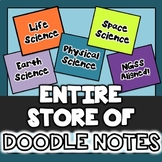Earth's Systems MS ESS2 | Science Doodle Note NGSS Vocabulary | BUNDLE
- Zip
What educators are saying
Products in this Bundle (6)
showing 1-5 of 6 products
Also included in
- Doodle notes to help build NGSS vocabulary skills. Use these science notes to parallel your lessons and add visual triggers to improve memory of content. These doodle notes specifically address the NGSS standards for middle school, while providing concrete visuals to support learners of all abilitiPrice $172.45Original Price $215.56Save $43.11
- ESS Vocabulary SCIENCE Doodle Note Bundle for ALL Middle School Earth and Space Science Key Ideas(Watch the video preview for an overview of what pages are included.)Interactive doodle note glossary for supporting the core ideas listed in the EARTH and SPACE Next Generation Science Standards for midPrice $60.68Original Price $75.85Save $15.17
- This doodle note bundle includes a huge variety of middle school science notes. These doodle notes have been used in my classroom and so many others. They will engage your students and save you hours of time!This product is listed at a 30% discount. Any new doodle note resources added to my TpT stoPrice $323.11Original Price $403.89Save $80.78
Description
This set of middle school NGSS doodle notes reviews the core ideas listed in the EARTH SCIENCE Next Generation Science Standards (MS ESS2 Earth's Systems) for grade 6-8. It serves as an interactive glossary where students respond to each term with a short task to improve memory. They are great for scaffolding, reinforcement and remediation of key vocabulary. (Be sure to open the preview to see what is included.)
Doodle notes can improve memory through visual triggers, while encouraging cross-lateral brain activity. These easy-to-prep, print and go doodle sheets will help support and reinforce your middle school physical science lessons.
This Interactive Glossary Tool covers:
MS-ESS 2-1
MS-ESS 2-2
MS-ESS 2-3
MS-ESS 2-4
MS-ESS 2-5
MS-ESS 2-6
Reviewing science vocabulary can be a lot of fun with DOODLE NOTES!
Can be used for...
- Bell Ringer Work
- End of a Unit (or end of the year) Review
- Year-long Science Glossary Project
- Science Notebooks (print at 85% to fit marble composition notebooks)
- Enlarge on 11 x 17 to make classroom posters that students help create!
Includes
30 Doodle Note Pages specifically aligned to NGSS Earth and Space Science 2
(2 versions provided: one with more white space/flexibility)
Most words have a short student task to improve memory of the concept (see preview images for samples)
30 Completed and colored example pages (answer keys)
Where can I get the other NGSS Doodle Notes to go with this?
ALL of my NGSS Doodle Notes Bundle 20% OFF
NGSS Physical Science Doodle Vocabulary Bundle 20% OFF
NGSS Matter and Interactions Doodle Notes Interactive Glossary
NGSS Motion and Stability Forces Doodle Notes Interactive Glossary
NGSS Energy Doodle Notes Interactive Glossary
Other KCC Doodle Lessons!
All my DOODLE NOTES in ONE PLACE!
Please note all doodle notes are NOT editable files due to font and clipart licensing agreements.








